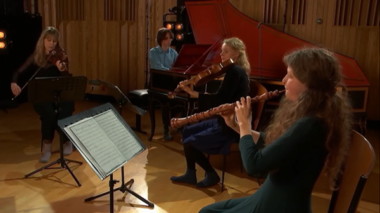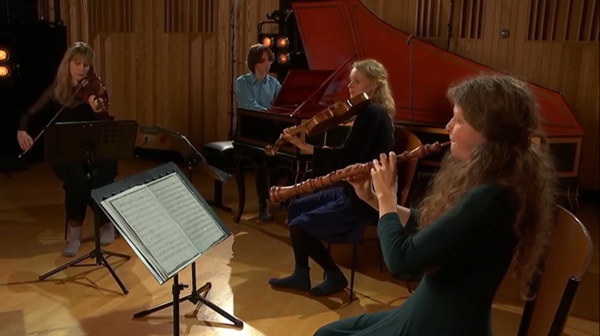 United Kingdom O Haupt! – Music by Telemann, J. S. Bach, Janitsch and C. P. E. Bach: Musica Gloria. The New Town Church, Edinburgh, 23.11.2024. (CC)
United Kingdom O Haupt! – Music by Telemann, J. S. Bach, Janitsch and C. P. E. Bach: Musica Gloria. The New Town Church, Edinburgh, 23.11.2024. (CC)

Musica Gloria: Nele Vertommen (Baroque oboe), Elise Dupont (violin), Lena Rademann (viola), Anne-Linde Visser (cello), Beniamino Paganini (harpsichord)
Order of performance:
Telemann – Tafelmusik: Oboe Sonata in G minor, TWV 41:g5. Fantasia for harpsichord in G minor, TWV 33:8.
J. S. Bach – Chorale, ‘O Haupt voll Blut und Wunder’
Janitsch – Sonata da Camera in G minor, ‘O Haupt voll Blut und Wunder’Telemann – Trio Sonata for violin, viola & continuo in D, TWV 42:D11, Oboe Concerto in D, TWV 51:D5: Adagio.
J. S. Bach – Sonata for Violin and Keyboard in A, BWV 1015
Telemann – Fantasia for traverso in G minor, TWV 40:13. Suite for traverso, violin and bass in D minor, TWV 42:13
J. S. Bach – Cello Suite in G, BWV 1007: Menuet II
C. P. E. Bach – Oboe Sonata in G minor, H 549 / Wq 135
Telemann – Sonata for recorder, violin and continuo, TWV 42: F8
Janitsch – Quartet in C minor
This was the UK debut of the excellent ensemble Musica Gloria: a group I first encountered in Ton Koopman’s vibrant Baroque Itinéraire festival this very year (in the Dordogne’s Église Saint-Martin de Champeaux: review here). Their disc Corelli & Händel: Encounters in Rome on the Etcetera label features the Claviroganum as well.as presenting a fascinating programme., both engaging and educational. But it is clear, too, that Musica Gloria thrives on the live environment. Both in France and in Scotland, everything went up a notch in the flesh. The freshness and vivacity of youth is writ large in their performances; but these are wise heads on young shoulders. Everything is carefully considered, including balance, tuning and style.
Here, they presented O Haupt!, an evening they describe as ‘an ode to German instrumental chamber music from the first half of the eighteenth century’. In presenting a rich panoply of pieces, they seem to present every combination of the instruments available (not just four, although there are four players: there is some mightily impressive multi-instrumentalism going on here). The biggest surprise was when the harpsichordist, Beniamino Paganini, stood up to play the traverso (and well, at that).
The thought behind the concert is indeed the chorale O Haupt voll Blut und Wunden, known to many via Bach’s Matthäus-Passion. Its appearance crowned the first ‘part’ of the concert presented with no interval via Janitsch’s Sonata da camera in G minor (the key of the earlier part of the concert), preceded by a ‘pure’ statement of the chorale. Johann Gottlieb Janitsch (1708-c.1763) was known for his contrapuntal mastery and his ability to treat each instrument equally, something very much on display in this performance, its sound much enriched by viola player Lena Rademann. And certainly, there was equal emphasis on violin and viola, Rademann and violinist Elise Dupont working powerfully together. Janitsch’s crunchy harmonies in the opening Largo e maestoso bit to the core. The textures were woven in spellbinding fashion, underpinned by a solid basso continuo, while Vertommen’s oboe sang expressively. The third movement, which holds that chorale, does inevitably sound more Bachian by melodic association; Janitsch’s processes tend more overtly in that JSB direction, too. The chorale, heard as slow-moving cantus firmus, grounded the melodic flowerings around it. Simply glorious; intriguingly, t was the Vivace finale that formed the concert’s encore, a bright and breezy way to send us out into the snow.
What warmed my heart was the emphasis on Telemann in the programme. That is another link to Itinéraire Baroque, of course: in 2017 they celebrated ‘Telemann Year’ in great style. It was Telemann who launched the concert as a whole in Edinburgh: his Oboe Sonata in G minor from Tafelmusik (or, as some prefer, Musique de table). What elevated Musica Gloria’s performance was the emphasis on Telemann’s imagination: the notable use of chromaticism in the harpsichord, for example. Vertommen is a stunning Baroque oboe player: she has tamed this unpredictable beast in no uncertain fashion. This was the very essence of chamber music, and oboe and Beniamino Paganini’s harpsichord together worked beautifully. Also, Vertommen can terrace her dynamics beautifully; and with that, Telemann’s music truly comes alive. Another aspect of the performance was to echo throughout the evening: the group’s propensity to find just the right tempos for the music. The entire performance of the Oboe Sonata exuded rightness; and then segued into the solo harpsichord Fantasia in G minor (TWV 33:8). Although one might think one ‘knows’ Telemann (the ever so clear-cut lines and forms, for example, or the never-ending melodic genius), he always surprises: Paganini found parallels in Telemann’s writing to C. P. E. Bach here (apt, given that composer did appear, later).
Telemann launched the second part of the evening, too (the music was performed in ‘segments’ which gave an opportunity for vital tuning sessions in between, a very necessary part of live Baroque performance!). The Trio Sonata in D, TWV 42:D11 is scored for violin, viola and continuo, robust in its opening Allegro (although I did wonder if just a bit more care in the violin’s articulation would pay dividends here), gallant in the central Adagio and back out into the open air for the final Vivace, a feat of some virtuosity. Only one movement of a Telemann Oboe Concerto next, but what a heavenly one, with Vertommen’s oboe ravishing. It is an interesting movement, the third of four in its original context. ‘Interesting’ because it starts as if it will present only an embellished cadence before confounding expectations and allowing for a long, long melody; even cadential moments are confounded by the melodic line on occasion. Two movements from a Bach Sonata for Violin and Harpsichord (A major, BWV 1015) rounded off this segment: the final two (of four), an Andante un poco finding Dupont’s violin soaring against Paganini’s ornate harpsichord, the final Presto an outflowing of Bach’s invention, honoured by a fabulous rhythmic sense from Dupont and Paganini.
Then the surprise of Paganini in Telemann’s Fantasia for traverso in G minor. The opening is like a slow study in Baroque gesture before a sprightly Allegro. The piece is short but magnificent. There are lots of examples of multiple ‘voices’ implied by one instrument: JSB is clearly not the only one who is a master at this. It was coupled with a Suite for traverso, violin and bass in D minor, TWV 42:d3, in seven sections. The seven are perfectly balanced, requiring quicksilver reactions from all (and certainly receiving just that here). It is a multi-faceted jewel of a piece.
It was a nice idea to slot in something of an interlude: Anne-Linde Visser getting her moment in the spotlight via a Menuet from Bach’s Cello Suite, BWV 1007 (she is compelling: I would love to hear full suites from her): Visser’s playing is unfussy yet beautifully phrased, her sound cherishable and full. Then, that C. P. E. Bach mentioned earlier: two movements from his Oboe Sonata in G minor, the opening Adagio, and the Vivace finale (there is a second movement Allegro not heard here). C. P. E.’s magic is the way he is so unpredictable, and yet so perfectly of his time. Angular though lines may be, they move inexorably to their destinations. A masterly performance from Vertommen here.
The final two ‘parts’ of the evening held one work each. It was not Telemann who closed, instead he was heard penultimately in the Sonata for recorder, violin and continuo, TWV 42:F8. Musica Gloria found such expressivity in the opening Andante (with Vertommen on recorder here). The blossoming of dialogue between recorder and violin in this piece is from the hand of a Master, and Musica Gloria made it all sound so blissfully natural.
Nice to end with a tutti piece though: one of Janitsch’s quartets (this in C minor). The group refused to over-indulge in the Poco largo (taking the ‘poco’ to heart) and the music sounded even more expressive for it. Robust counterpoint characterised the central ‘Alla breve’ before a finale taken exactly at the composer’s requested Allegro moderato: the music active, but with space to breathe.
Amazing to think this is Musca Gloria’s first visit to the UK; may there be many more. The acoustic of the circular new Town Church has just the right amount of bloom for a chamber ensemble without any blurring. The full and appreciative audience seemed thrilled; as well they might be.
This concert will be repeated in The Hague on November 28 at the Lutherse Kerk.
Colin Clarke
